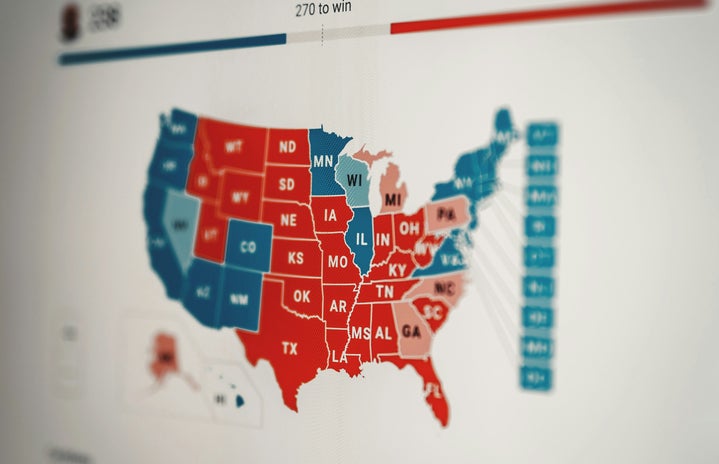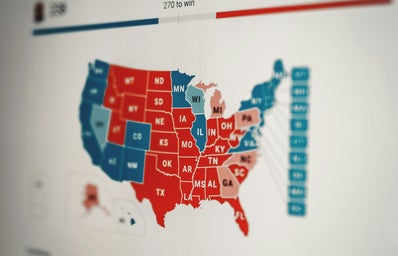When people think of the United States, a few words might come to mind: Freedom, Trump, maybe Hollywood, but most importantly: democracy. However, the term “democracy” is often misconstrued, because the U.S. government doesn’t actually operate as a direct democracy; it functions as a federal constitutional republic. This means that the U.S. government is based on the Constitution that our Founding Fathers penned. It has a national government with subsequent local governments, and U.S. citizens elect representatives to exercise power instead of directly voting for the president.
The last component is critical, because it reflects how our president is ultimately chosen every four years: through the electoral college.

Where it all began
Before we talk about the electoral college’s political climate, we need to understand how it started. So, let us go back to 1787, at the Constitutional Convention (my AP US History knowledge is finally being put to use!). The founding fathers gathered in Philadelphia to discuss how our government would function – not the most exciting part of history, I know, but essential, nonetheless.
They argued for months over how to elect the president. The result, called the Great Compromise, entailed that every state would get equal representation in the Senate via two senators and proportional representation via the House of Representatives. Ultimately, this is how the Electoral System was created – a system built out of compromise.
Currently, the Electoral College consists of a group of presidential electors from both the Democratic party and the GOP. U.S. voters do not vote directly for the president; instead, the majority vote for president in each state is used as a guideline for how the chosen presidential electors vote for that state. It’s important to note that in some states, electors are not required to vote the same way that the majority of their state did, but they almost always do.
There are 538 electors, equivalent to the 100 senators and 435 state representatives (plus an additional three electors for Washington, D.C.). The presidential candidate who receives 270 electoral votes wins the presidency.
A presidential candidate can win the popular vote (which is a form of direct democracy), but not the electoral college, and therefore not be awarded the presidency. Unfortunately, this is not just a hypothetical situation – it occurred in 2000 with President Bush v. Gore and again in 2016 with President Trump v. Clinton.
An imbalance power across states
The Electoral College, in its current form, ultimately diminishes the power of citizens in larger states, while giving the smaller states more control. This system isn’t accidental. In 1787, smaller states favored the electoral college during the Constitutional Convention because it allowed them a larger voice despite their smaller population sizes. The southern states, where most of the slaves were located, supported this electoral based system because even though slaves could not vote, they counted as 3/5 of a person, thus increasing their population size. The result was that southern states had more power than if the president was elected by white men voting directly.
Where we can go from here
A hot topic of conversation currently is the debate over whether or not we, as a country, should continue to use the electoral college for presidential elections. On the one hand, some may argue that there’s a chance of the majority’s tyranny without the electoral college. One of the reasons the electoral college was established was to limit the power of the larger states. This thinking is somewhat flawed because, even if the electoral college system is changed, smaller states still have an equal representation within the Senate. Some proponents of the electoral college argue that if it were abolished, then presidential candidates would only focus on campaigning in populous states such as California. Yet, in the current system, they mostly focus on swing states such as Michigan or Florida.
Another problem within the current presidential voting system is third parties. Third parties, in theory, are useful for providing a more expansive array of presidential candidates and ideas. In reality, voting for third parties can ultimately take votes away from the overwhelmingly preferred presidential candidate. An alternative to eliminating the electoral college and mitigating other third parties’ problems is rank-choice voting.
Maine utilized rank-choice voting for their senate race this year and the presidential election. The rank choice voting system allows voters to rank the candidates in order of preference. If their first preference does not get the majority, their lowest ranked-choice is eliminated, and their second-choice candidate gets their vote. This process will repeat until two candidates remain where a final winner is determined (However, it is essential to note that voters are not required to pick multiple candidates; they can choose one).
In the year 2020, the presidential candidate should represent the majority of the country. To remedy this electoral based system, it ultimately comes down to either eliminating the electoral college or mitigating its adverse effects through ranked-choice voting. Gen Z is slowly becoming of voting age. Typically red states, through demographic shifts, are becoming swing states. It won’t be easy, but the overhaul of our governmental system may be on the horizon. We’ll just have to wait and see.



